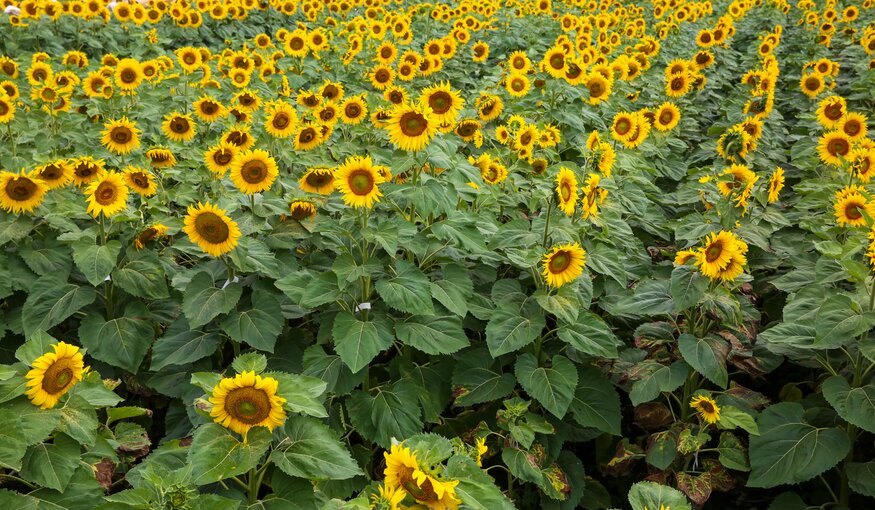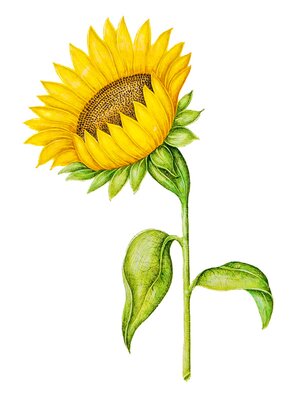The Wonderful World of Sunflowers

Sunflower in Argentina. Photo: Luis Salazar for Crop Trust
6 November 2023
Think about sunflowers, and there is a good chance that Vincent van Gogh's masterful artworks will leap to mind. His series of sunflower paintings, created in the late 19th century, are timeless representations of the flower's beauty, radiance, and symbolic depth.
But did you know that the crop originated far from van Gogh’s homeland in the Netherlands. Domesticated about 4,000 years ago by First Nations peoples in North America, the crop is now best known for the cooking oil extracted from its seeds, but it is also used as a forage crop, in confectionery, as food for pet birds, as an ornamental plant in gardens around the world, and in the cut-flower industry.
Threatened Diversity
 There are some 50 wild relatives of the sunflower, all native to North America. They include both annuals — like the cultivated sunflower itself, Helianthus annuus — and perennials. These species occupy an incredibly wide range of habitats, from climax forests to coastal dunes to tallgrass prairie to wetlands, providing a wealth of diversity to help future-proof the sunflower crop and even expand its range.
There are some 50 wild relatives of the sunflower, all native to North America. They include both annuals — like the cultivated sunflower itself, Helianthus annuus — and perennials. These species occupy an incredibly wide range of habitats, from climax forests to coastal dunes to tallgrass prairie to wetlands, providing a wealth of diversity to help future-proof the sunflower crop and even expand its range.
Current estimates suggest that the cultivated sunflower has only between half and two-thirds of the genetic diversity present in its wild version. Breeders will need to be able to tap into the diversity of these wild relatives if they are to breed the crops future farmers will need to confront the challenges they face.
But, as with most crops, climate change and changes in land-use and farming practices pose challenges for sunflower diversity.
What Diversity is Held, Where?
That is one reason why, in 2021, the Crop Trust conducted a study of sunflower collections around the world as part of a German-Government-funded project to develop global crop conservation strategies. The Global Strategy for the Conservation and Use of Sunflower (Helianthus annuus) Genetic Resources, published in 2023, is one of the results.
This identified more than 100 institutes around the world holding a total of more than 40,000 accessions of sunflower and its wild relatives. However, only 19 institutes held about 90% of the seed samples, and more than half of the collections consisted of fewer than 50 samples.
The largest and most comprehensive collection is held by the United States Department of Agriculture National Plant Germplasm System (USDA-NPGS), with more than 5,000 samples of 53 Helianthus species. But even this has some gaps, particularly diversity from Mexico, which represents the southern range limit of several Helianthus species. These gaps represent a significant risk for the long-term improvement of the cultivated sunflower. “The low level of safety duplication among the genebanks holding sunflower germplasm is another area of concern,” said Peter Giovannini, one of the authors of the strategy and Coordinator Global Crop Conservation Strategies at the Crop Trust.
The strategy envisages a partnership among North American countries to address collection gaps for cultivated landraces and wild relatives. “A relatively modest investment would go a long way toward collecting and conserving Mexican and Canadian genetic resources of sunflower,” noted the authors of the strategy.
However, addressing the low level of safety duplication of sunflower diversity already in genebanks is as important as collecting new diversity. All seed samples that are not already safety duplicated could be sent to USDA for regeneration and backup and, ideally, to the Svalbard Global Seed Vault as well.
The accessibility of genetic diversity also needs to be increased. A key way to do this is making more and better data on collections available.
Finally, the strategy’s authors recommend establishing “a global international advisory group for the engagement of key collection holders and main users of sunflower genetic resources, and to lead the implementation of agreed priority activities.”
“Although there is not a formal international sunflower collection, there are key collections identified in the strategy that can work together toward the common goal of conserving and facilitating the use of sunflower genetic resources,” said Giovannini.
The Future is Looking Sunny
So, whether sunflowers bring to mind images of endurance, strength and resilience, of Vincent van Gogh’s paintings or the ubiquitous cooking oil, the new sunflower global conservation strategy will help ensure the crop is ready for whatever the future has to throw at it.
Categories: Global Crop Conservation Strategies, Sunflower
About the Global Crop Conservation Strategy project
The development of this Global Crop Conservation Strategy was funded by the German Federal Ministry of Food and Agriculture (BMEL) as part of a three-year project led by the Crop Trust: “Breathing New Life into the Global Crop Conservation Strategies: Providing an Evidence Base for the Global System of Ex situ Conservation of Crop Diversity.”
